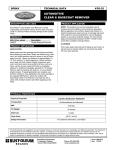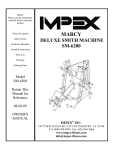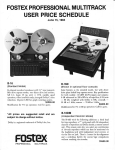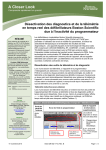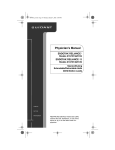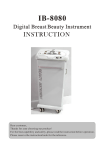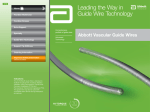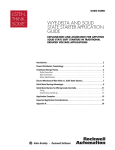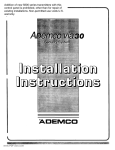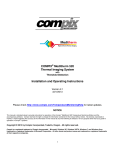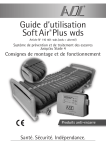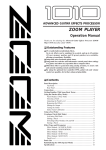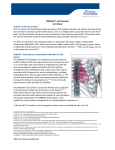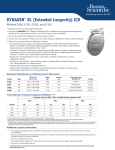Download CRM Product Guide
Transcript
CRM Product Guide Pacing, Defibrillation, and Cardiac Resynchronization Therapy December 2008 Dielines do not print Pacing Pulse Generators Pacemakers..................................................................................................................................................5 Defibrillation Pulse Generators Implantable Cardioverter Defibrillators (ICDs)..................................................................................7 Cardiac Resynchronization Therapy Pulse Generators Cardiac Resynchronization Therapy Defibrillators (CRT-Ds)......................................................11 Cardiac Resynchronization Therapy Pacemakers (CRT-Ps)..................................................17 Pacing Leads and Accessories Pacing Leads..............................................................................................................................................19 Pacing Lead Accessories.......................................................................................................................21 Pacing Lead Stylets.................................................................................................................................23 Defibrillation Leads and Accessories Defibrillation Leads..................................................................................................................................25 Defibrillation Lead Accessories...........................................................................................................27 Defibrillation Lead Stylets.....................................................................................................................31 Cardiac Resynchronization Therapy Leads and Accessories CRT Leads.......................................................................................................................................... 33 Guide Catheters............................................................................................................................... 35 Guide Wires.......................................................................................................................................41 Finishing Wires................................................................................................................................ 46 LV-1 Accessories............................................................................................................................. 48 IS-1 Accessories.............................................................................................................................. 50 Frequently Used Accessories....................................................................................................... 52 Other Accessories........................................................................................................................... 54 Compatibility Charts....................................................................................................................... 56 Dielines do not print The LATITUDE® Patient Management system is compatible with virtually all Boston Scientific ICD and CRT-D devices. LATITUDE Wanded Communicator (Model 6481) CRT-D H115 H119 H135 H170 H175 H177 H179 CONTAK® CD 2 CONTAK CD 2 HE CONTAK RENEWAL® CONTAK RENEWAL 3 CONTAK RENEWAL 3 CONTAK RENEWAL 3 HE CONTAK RENEWAL 3 HE ICD 1850 1852 1857 1860 1851 1853 1858 1861 VENTAK PRIZM® VR VENTAK PRIZM VR HE VENTAK PRIZM VR HE VENTAK PRIZM 2 VR VENTAK PRIZM DR VENTAK PRIZM DR HE VENTAK PRIZM DR HE VENTAK PRIZM 2 DR ICD T135 T125 T127 T180 T165 T167 T175 T177 VITALITY® DS VR VITALITY DS DR VITALITY EL DR VITALITY HE VITALITY 2 DR VITALITY 2 EL DR VITALITY 2 VR VITALITY 2 EL VR LATITUDE Push Button Wireless Communicator (Model 6482) CRT-D Wireless H210 CONTAK RENEWAL 3 RF H215 CONTAK RENEWAL 3 RF H217 CONTAK RENEWAL 3 RF HE H219 CONTAK RENEWAL 3 RF HE CRT-D Wireless H220 LIVIAN RF H225 LIVIAN RF H227 LIVIAN RF HE H229 LIVIAN RF HE TM LATITUDE® Touch Screen Wireless Communicator (Model 6476) CRT-D Wireless N118 COGNIS RF HE N119 COGNIS RF HE TM ICD Wireless E102 TELIGEN VR RF HE E110 TELIGEN DR RF HE TM 4 ICD Wireless E030 CONFIENT RF HE TM Model Type Longevity (years) Volume (cc) Thickness (mm) Header -AV Delay extendable to 400 ms -M V Blended Sensor -S tored Onset EGMs -A utomatic Capture -AV Search Hysteresis -A utoLifestyle ® -Ventricular Rate Regulation -Sudden Brady Response S601 S602 S603 S606 SR DR DR DR 8.6 1 8.8 1 6.51 8.8 1 10.0 12.6 10.8 12.6 8 8 8 8 IS-1 3.2 mm/IS-1 compatible IS-1 IS-1 -M V Blended Sensor -S tored Onset EGMs -AV Search Hysteresis -Ventricular Rate Regulation -Sudden Brady Response S401 S403 S404 SR DR DR 7.7 2 5.9 2 8.12 10.0 10.8 12.6 8 8 8 IS-1 IS-1 IS-1 -S tored Onset EGMs -Accelerometer Sensor -D ynamic AV Delay -Sudden Brady Response S201 S203 S204 S205 S208 Product Description ALTRUA™ 60 ALTRUA 40 ALTRUA 20 Diagram 5 SR DR SR DR DR 9.6 3 7.13 9.6 3 9.7 3 9.7 3 10.1 10.8 11.0 14.9 12.6 8 8 8 8 8 3.2 mm/IS-1 compatible IS-1 5/6 mm 5/6 mm IS-1 1 L ongevity projections as described in device user manual. Settings: 60 ppm, A=2.5 V, V=1.0 V, 500 ohms, 100% paced, MV Blended Sensor ON, Onset EGMs ON, Automatic Capture ON. 2 L ongevity projection as described in user manual. Settings: 60 ppm, A=2.5 V, V=2.5 V, 500 ohms, 100% paced, MV Blended Sensor ON, Onset EGMS ON. 3 L ongevity projection as described in user manual. Settings: 60 ppm, A=2.5 V, V=2.5 V, 500 ohms, 100% paced, Accelerometer Sensor ON, Onset EGMS ON. Pacemakers Dielines do not print Dielines do not print Model Type Energy (J) Warranty (years) Volume (cc) Thickness (mm) Header -Safety Core™ and Safety Architecture -Q uick Convert ™ -Rhythm ID ® and OBDE in the same device -2 -zone nominals -AV Search + (up to 400 ms) -L i MnO 2 battery for extended longevity* and fast, consistent charge times over the life of the device -Programmable shock vectors -Indications-based programming -Respiratory rate trend -17 minutes of EGM storage, 3 channels on -Ventricular Rate Regulation E102 E110 VR DR 41 41 7 31.5 31.5 9.9 9.9 DF-1/IS-1 DF-1/IS-1 -4 00 ms AV Delay -AV Search Hysteresis -C ompatible with LATITUDE Patient Management System -S tored EGMs w/Onset -Ventricular Rate Regulation -Advanced battery technology E030 Product Description TELIGEN™ CONFIENT™ - 7 DR 41 *As compared with previous Boston Scientific devices Dielines do not print Diagram ICDs 5 44 14.5 DF-1/IS-1 Dielines do not print ICDs Model Type Energy (J) Warranty (years) Volume (cc) Thickness (mm) -R hythm ID -AV Search Hysteresis (DR only) -Ventricular Rate Regulation -F ullView ™ Stored EGMs w/Onset -Interval Graph -My Patient Profile with Quick Profiles ™ T165 T175 DR VR 31 31 5 5 30 30 11 DF-1/IS-1 DF-1/IS-1 -R hythm ID -AV Search Hysteresis (DR only) -Ventricular Rate Regulation -FullView Stored EGMs w/Onset -Interval Graph -M y Patient Profile with Quick Profiles T167 T177 DR VR 31 31 7 7 35 35 11 DF-1/IS-1 DF-1/IS-1 -A utomatic Atrial ATP -A trial Rhythm Classification -A trial Pacing Preference -C ardioversion -ProACt -Ventricular Rate Regulation -AV Search Hysteresis -FullView Stored EGMs w/Onset -Shock If Unstable -M y Patient Profile A155 Product Description VITALITY® 2 VITALITY 2 EL VITALITY AVT® Header Diagram 8 DR 31 5 30 11 DF-1/IS-1 Model Type Energy (J) Warranty (years) Volume (cc) Thickness (mm) Header -AV Search Hysteresis -F ullView Stored EGMs w/Onset -Daily Measurements -Shock If Unstable -Patient-triggered Monitor T125 T135 DR VR 31 31 5 5 30 30 11 DF-1/IS-1 -AV Search Hysteresis -F ullView Stored EGMs w/Onset -Daily Measurements -Shock If Unstable -Patient-triggered Monitor T127 DR 31 7 35 11 DF-1/IS-1 -AV Search Hysteresis (DR only) -E nergy-efficient Episode Onset -3 -channel Stored EGMs (DR only) -Shock If Unstable 1852 1853 1857 1858 Product Description VITALITY DS VITALITY EL VENTAK PRIZM ® HE Dielines do not print Diagram 9 VR DR VR DR 41 41 41 41 4 4 4 4 38 39 43 45 15 15 15 15 DF-1/IS-1 DF-1/IS-1 6.1 mm/4.75 mm 6.1 mm/4.75 mm IS-1 atrial Dielines do not print Product Description COGNIS™ -Safety Core and Safety Architecture -Quick Convert -SmartDelay™ algorithm for quick AV delay programming recommendations intended to provide optimally timed CRT -Electronic Repositioning™ with 6 configurations with bipolar leads -BiV Trigger and VRR -Rhythm ID and OBDE in the same device -Programmable shock vectors -L i MnO 2 battery for extended longevity* and fast, consistent charge times over the life of the device -Respiratory rate trend -2-zone nominals -Indications-based programming -17 minutes of EGM storage, 3 channels on Model Energy (J) Warranty (years) Volume (cc) Thickness (mm) Header N118 N119 41 41 5 5 32.5 32.5 9.9 9.9 IS-1/DF-1:LV-1 IS-1/DF-1:IS-1 Diagram 11 *As compared with previous Boston Scientific devices Dielines do not print CRT-Ds Dielines do not print CRT-Ds Product Description LIVIAN™ -SmartDelay algorithm for quick AV delay programming recommendations intended to provide optimally timed CRT -BiV Trigger and VRR -C ompatible with LATITUDE Patient Management System -E lectronic Repositioning -S tored EGMs with Onset -A dvanced battery technology LIVIAN HE Model Energy (J) Warranty (years) Volume (cc) Thickness (mm) Header H220 H225 31 31 4 40 40 14.5 14.5 IS-1 IS-1/LV-1 H227 H229 41 41 4 44 44 14.5 14.5 IS-1 IS-1/LV-1 Diagram 12 Product Description CONTAK RENEWAL 3 ® CONTAK RENEWAL 3 HE -Independent channels for right and left ventricular pacing and sensing -Patient-centric diagnostics: -HRV Monitor Footprint -ABM -HRV Monitor Trending -Activity Log -High-energy output -VRR -Fast charge time -Daily measurements Model Energy (J) Warranty (years) Volume (cc) Thickness (mm) Header H170 H175 31 31 3+2 37 37 11.5 11.5 IS-1 LV-1 H177 H179 41 41 3+1 40 40 11.5 11.5 IS-1 LV-1 Diagram 13 Dielines do not print Product Description CONTAK RENEWAL 3 RF -Independent channels for right and left ventricular pacing and sensing -Patient-centric diagnostics: -Patient-triggered monitor -Heart rate variability (HRV) Monitor Footprint -Automatic Balance Monitor (ABM) -HRV Monitor Trending -Activity Log -Snapshot viewer -Ventricular Rate Regulation -Fast charge time -Daily measurements -Enhanced telemetry communication with ZIP™ wandless telemetry CONTAK RENEWAL 3 RF HE Dielines do not print Model Energy (J) Warranty (years) Volume (cc) Thickness (mm) Header H210 H215 31 31 3+2 39 39 14 14 IS-1 LV-1 H217 H219 41 41 3+1 43 43 14 14 IS-1 LV-1 Diagram 14 Product Description CONTAK RENEWAL -Independent channels for right and left ventricular pacing and sensing -Patient-centric diagnostics: -Heart rate variability (HRV) Monitor Footprint -HRV Monitor Trending -Activity Log -Ventricular Rate Regulation Model Energy (J) Warranty (years) Volume (cc) Thickness (mm) Header H135 31 3+2 45 15 LV-1 Diagram 15 Dielines do not print Dielines do not print Product Description CONTAK RENEWAL TR -Independent channels for right and left ventricular pacing and sensing -Patient-centric diagnostics: -Heart rate variability (HRV) Monitor Footprint -HRV Monitor Trending -Activity Log -Ventricular Rate Regulation -Daily measurements -110 sec EGM storage Model H120 H125 Warranty (years) Volume (cc) Thickness (mm) Header 5 14 14 8.5 8.5 IS-1 LV-1 Diagram 17 CRT-Ps Dielines do not print Dielines do not print Due to variations among introducer manufacturers, please call CRM Technical Services at 1.800.CARDIAC for specific recommendations regarding introducer sizes Product Description Model Length (cm) Insulation FINELINE II STEROX EZ Active Fixation -4 turns (55D poly), -6 turns (silicone) -IROX ® -coated tip electrode -T hin co-radial design -IS-1 -S teroid elution -Bipolar 4469 4470 4471 4472 4473 4474 45 52 58 45 52 58 55D Poly 55D Poly 55D Poly Silicone Silicone Silicone FINELINE II STEROX Atrial-J Passive Fixation -Preformed J -IROX-coated tip electrode -T hin co-radial design -IS-1 -S teroid elution -Bipolar -T ined fixation 4479 4480 45 52 55D Poly 55D Poly -IROX-coated tip electrode -T hin co-radial design -IS-1 -S teroid elution -Bipolar -T ined fixation 4456 4457 4458 4459 ® FINELINE II STEROX Passive Fixation Dielines do not print Diagram 19 52 58 52 58 55D Poly 55D Poly Silicone Silicone Pacing Leads Dielines do not print Pacing Leads Model Length (cm) Insulation -E xtendable/retractable -8 turns (minimum) -Iridium-coated tip electrode -IS-1 -S teroid elution -Bipolar 4135 4136 4137 45 53 60 Silicone Silicone Silicone -E xtendable/retractable -6 –8 turns -IS-1 -S teroid elution -Bipolar 4086 4087 4088 45 52 59 Silicone Silicone Silicone Product Description DEXTRUS™ Active Fixation FLEXTEND ® Active Fixation Diagram 20 Product From To Lead Adapter Sleeve 6016 (1) 3.2 mm low-profile or IS-1 unipolar connector (1) 5 mm unipolar terminal Lead Adapter 6017 (1) 3.2 mm low-profile or IS-1 bipolar connector (1) 4.75 mm bifurcated bipolar terminal 16 Lead Adapter 6018 (1) 6.1 mm unipolar connector (1) 3.2 mm low-profile unipolar terminal 15 Lead Adapter 6020 (1) 4.75 mm unipolar connector (1) 3.2 mm low-profile unipolar terminal 15 Lead Adapter Sleeve 6022 (1) 3.2 mm low-profile or IS-1 connector (1) 6 mm unipolar terminal Lead Adapter (Uses 2-unipolar4.75 mm or 1-Bif. Bipolar 4.75 mm) 6024 (2) 4.75 mm connectors (1) IS-1 bipolar terminal Dielines do not print Model Length (cm) Diagram N/A 21 N/A 16 Pacing Lead Accessories Dielines do not print Product Pacing Lead Accessories Model From To Length (cm) Lead Cap Kit 6504 (2) 3.2 mm or (2) 4.75 mm connectors N/A N/A Lead Adapter Sleeve 6526 (2) 4.75 mm connectors (1) 6 mm terminal N/A Lead Cap Kit 6811 (2) 4.75 mm connectors N/A N/A Lead Adapter 6986 (1) IS-1 or 3.2 mm low-profile bipolar connector (1) IS-1 bipolar terminal 14 Lead Extender/Adapter 6987 (1) IS-1 or 3.2 mm low-profile bipolar connector (1) IS-1 bipolar terminal 45 IS-1 Port Plug (1) 6998 N/A (2) IS-1 terminals N/A Diagram 22 Pacing Stylets Type Wide Atrial J Wide Atrial J Wide Atrial J Wide Atrial J Wide Atrial J Wide Atrial J Length Diameter (cm) Firmness (in) Model Knob Color Cap Color Type Length Diameter (cm) Firmness (in) Model Knob Color Cap Color 45 Soft 0.014 6053 Green White Straight 52 Firm 0.016 6583 White Red 45 Firm 0.016 6057 White White Straight 52 Soft 0.014 6585 Green Red 52 Soft 0.014 6054 Green Red Straight 59 Soft 0.014 6601 Green Yellow 52 Firm 0.016 6058 White Red Straight 59 Firm 0.016 6602 White Yellow 59 Soft 0.014 6055 Green Yellow Atrial J 45 Soft 0.014 6506 Green White 59 Firm 0.016 6059 White Yellow Atrial J 45 Firm 0.016 6508 White White Straight 45 Soft 0.014 6505 Green White Atrial J 52 Firm 0.016 6584 White Red Straight 45 Firm 0.016 6507 White White Atrial J 59 Soft 0.014 6603 Green Yellow Straight 52 Soft 0.014 6585 Green Red Atrial J 59 Firm 0.016 6604 White Yellow Pacing Lead Stylets Dielines do not print 23 Pacing Lead Stylets Dielines do not print FINELINE Stylets Type Length Diameter (cm) Firmness (in) Model Knob Color Cap Color Type Yellow Yellow Atrial J 58 Soft 0.013 Length Diameter (cm) Firmness (in) Model Knob Color Cap Color Tapered 45 Soft 0.013 6044 Tapered 45 Limber 0.014 6032 Green Yellow Atrial J 58 Limber 0.014 Tapered 45 Firm 0.016 6035 White Yellow Atrial J 58 Firm 0.016 Tapered 52 Soft 0.013 6045 Yellow Mint Straight 45 Soft 0.013 6047 Yellow Purple 6040 Green Purple 6043 White Purple Yellow Yellow 6052 Tapered 52 Limber 0.014 6033 Green Mint Straight 45 Limber 0.014 6061 Green Yellow Tapered 52 Firm 0.016 6036 White Mint Straight 45 Firm 0.016 6064 White Yellow Tapered 58 Soft 0.013 6046 Yellow Purple Straight 52 Soft 0.013 6048 Yellow Mint Tapered 58 Limber 0.014 6034 Green Purple Straight 52 Limber 0.014 6062 Green Mint Tapered 58 Firm 0.016 6037 White Purple Straight 52 Firm 0.016 6065 White Mint Atrial J 45 Soft 0.013 6050 Yellow Yellow Straight 58 Soft 0.013 6049 Yellow Purple Atrial J 45 Limber 0.014 6038 Green Yellow Straight 58 Limber 0.014 6063 Green Purple Atrial J 45 Firm 0.016 6041 White Yellow Straight 58 Firm 0.016 6066 White Purple Atrial J 52 Soft 0.013 6051 Yellow Mint Atrial J 52 Limber 0.014 6039 Green Mint Atrial J 52 Firm 0.016 6042 White Mint 24 Product Description Model Length (cm) Insulation ENDOTAK RELIANCE G Active Fixation -ePTFE-covered coils -Terminal pin-driven -E xtendable/retractable -8 Turns (10 turns(0187)) -Dual-coil -DF-1/IS-1 -S teroid elution -Integrated bipolar 0184 0185 0186 0187 59 64 70 90 Silicone Silicone Silicone Silicone ENDOTAK RELIANCE SG Active Fixation -ePTFE-covered coil -Terminal Pin-driven -E xtendable/retractable -8 turns -Single-coil -DF-1/IS-1 -S teroid elution -Integrated bipolar 0180 0181 0182 59 64 70 Silicone Silicone Silicone ENDOTAK RELIANCE G Passive Fixation -ePTFE-covered coils -High Impedance -Dual-coil -DF-1/IS-1 -S teroid elution -Integrated bipolar 0174 0175 0176 0177 59 64 70 90 Silicone Silicone Silicone Silicone ENDOTAK RELIANCE SG Passive Fixation -ePTFE-covered coil -High Impedance -Single-coil -DF-1/IS-1 -S teroid elution -Integrated bipolar 0170 0171 0172 59 64 70 Silicone Silicone Silicone ® Dielines do not print Diagram 25 Defibrillation Leads Dielines do not print Defibrillation Leads Model Length (cm) -Terminal pin-driven -E xtendable/retractable -8 turns (0157, 0158) -10 turns (0159) -Dual-coil -DF-1/IS-1 -S teroid elution -Integrated bipolar 0157 0158 0159 59 64 90 Silicone Silicone Silicone Silicone -Terminal pin-driven -E xtendable/retractable -8 turns -Single-coil -DF-1/IS-1 -S teroid elution -Integrated bipolar 0137 0138 59 64 Silicone Silicone Silicone ENDOTAK RELIANCE Passive Fixation -High Impedance -Dual-coil -DF-1/IS-1 -S teroid elution -Integrated bipolar 0147 0148 0149 59 64 90 Silicone Silicone Silicone ENDOTAK RELIANCE S Passive Fixation -High Impedance -Single-coil -DF-1/IS-1 -S teroid elution -Integrated bipolar 0127 0128 59 64 Silicone Silicone Product Description ENDOTAK RELIANCE Active Fixation ENDOTAK RELIANCE S Active Fixation Insulation Diagram 26 Product Description ENDOTAK SQ Array XP ® -Subcutaneous lead array -DF-1 with built-in DF-1 port -3 common coils -Used with ENDOTAK leads Model Length (cm) Insulation 0085 70 Silicone Diagram 27 Dielines do not print Defibrillation Lead Accessories Dielines do not print Product Model From To DF-1 Port Plug (1) 6996 N/A (2) DF-1 terminals Length (cm) N/A TVI Tool Kit (For use with Reliance G leads) 7600 (1) 9F TVI tool (white handle) (1) 11F TVI tool (green handle) Hemostatic introducer N/A Lead Cap Kit 6623 (2) DF-1 (2) IS-1 (2) 4.75 mm connectors N/A N/A Lead Cap Kit 6810 (2) 6.1 mm connectors N/A N/A Lead Adapter 6833 (2) 6.1 mm connectors (1) DF-1 terminal 15 Lead Adapter 6835 (2) DF-1 connectors (1) DF-1 terminal 15 Diagram 28 Product From To Lead Adapter Model 6836 (2) 6.1 mm connectors (1) 6.1 mm terminal Length (cm) 15 Lead Adapter 6931 (1) 6.1 mm connector (1) DF-1 terminal 14 Diagram 29 Lead Adapter Dielines do not print 6952 (2) DF-1 and (1) IS-1 connectors (2) DF-1 and (1) IS-1 terminals 60 Dielines do not print Defibrillation Stylets Model Length (cm) Type Firmness Diameter (in) Knob Color Cap Color 6601 59 Straight Soft 0.014 Green Yellow 6602 59 Straight Firm 0.016 White Yellow 6771 90 Straight Firm 0.016 White Orange 6772 90 Straight Soft 0.014 Green Orange 6826 100 Straight Firm 0.016 White White 6828 100 Straight Soft 0.014 Green White 6963 70 Straight Firm 0.016 White Black 6964 70 Straight Soft 0.014 Green Black 6971 64 Straight Firm 0.016 White Green 6972 64 Straight Soft 0.014 Green Green Defibrillation Lead Stylets 31 Dielines do not print Dielines do not print Product Description Model Length (cm) Terminal Polarity ACUITY™ Steerable -Coronary venous pace/ sense lead -Either over-the-wire or stylet delivery -IROX electrode coating -IS-1 -Steroid elution -Pre-shaped J fixation 4554 80 IS-1 Bipolar 4555 90 -Coronary venous pace/ sense lead -Over-the-wire design -IROX electrode coating -IS-1 -Steroid elution -3-dimensional, spiral fixation 4591 80 IS-1 Unipolar 4592 90 ACUITY Spiral Dielines do not print CRT Leads Diagram 33 Dielines do not print CRT Leads Product Description EASYTRAK® 2 EASYTRAK 2 EASYTRAK 3 EASYTRAK 3 Model Length (cm) Terminal Polarity -Coronary venous pacing lead -Over-the-wire design -Steriod elution -Tined fixation 4517 80 LV-1 Bipolar 4518 90 4520 100 -Coronary venous pacing lead -Over-the-wire design -IS-1 -Steriod elution -Tined fixation 4542 80 IS-1 Bipolar 4543 90 4544 100 -Coronary venous pacing lead -Over-the-wire design -Steriod elution -3-dimensional, spiral fixation 4524 80 LV-1 Bipolar 4525 90 4527 100 -Coronary venous pacing lead -Over-the-wire design -IS-1 -Steriod elution -3-dimensional, spiral fixation 4548 80 4549 90 4550 100 Diagram 34 IS-1 Bipolar Product Description Intended use and features RAPIDO Coronary Sinus Inner Catheter 50 Compact (CS-IC 50C) guide catheter -Outer diameter (OD) – 6 French (F) -Inner diameter (ID) – 4.9F/0.064"/1.63 mm -C ompatible with RAPIDO ADVANCE ® and RAPIDO Cut-Away ® Provides access to the coronary venous system when used with an outer guide catheter ® 7720 Working length – 79 cm Overall length – 85 cm 7552 Working length – 69 cm Overall length – 75 cm RAPIDO Coronary Sinus Inner Catheter 90 (CS-IC 90) guide catheter 7721 Working length –79 cm Overall length – 85 cm 6776 Working length – 69 cm Overall length – 75 cm Dielines do not print units per package Diagram 1 • O ffers flexibility during coronary sinus (CS) cannulation • A ids in deep-seating outer catheter • F acilitates branch vein subselection • E nables selective venogram -OD – 6F -ID – 4.9F/0.064"/1.63 mm -C ompatible with RAPIDO and RAPIDO Cut-Away Provides access to the coronary venous system when used with an outer guide catheter 1 35 • O ffers flexibility during coronary sinus (CS) cannulation • A ids in deep-seating outer catheter • F acilitates branch vein subselection • E nables selective venogram Guide Catheters Dielines do not print Guide Catheters units per package Product Description Intended use and features RAPIDO ADVANCE Coronary Sinus Extended Hook (CS-EH) guide catheter -OD – 8F -ID – 6.6F/0.087"/2.21 mm -C ompatible with IS-1 and LV-1 EASYTRAK family of leads Catheter shape gains support from the superior vena cava (SVC) to provide access to the CS and branch vein for guide wire and direct lead delivery 1 -OD – 8F -ID – 6.6F/0.087"/2.21 mm -C ompatible with IS-1 and LV-1 EASYTRAK family of leads Catheter shape gains support from the superior vena cava (SVC) to provide access to the CS and branch vein for guide wire and direct lead delivery 1 7711 Working length – 47 cm Overall length – 53 cm Diagram 7712 Working length – 52 cm Overall length – 58 cm 7713 Working length – 57 cm Overall length – 63 cm RAPIDO ADVANCE Coronary Sinus Extended Hook Right (CS-EH R) guide catheter 7714 Working length – 47 cm Overall length – 53 cm 7715 Working length – 52 cm Overall length – 58 cm 7716 Working length – 57 cm Overall length – 63 cm 36 Product Description Intended use and features RAPIDO ADVANCE Coronary Sinus Extended Hook Straight Right (CS-EH ST R) guide catheter -OD – 8F -ID – 6.6F/0.087"/2.21 mm -C ompatible with IS-1 and LV-1 EASYTRAK family of leads Catheter shape gains support from the SVC to provide access to the CS and branch vein for guide wire and direct lead delivery units per package Diagram 1 7717 Working length – 47 cm Overall length – 53 cm 7718 Working length – 52 cm Overall length – 58 cm 7719 Working length – 57 cm Overall length – 63 cm 37 Dielines do not print units per package Product Description Intended use and features RAPIDO Cut-Away Coronary Sinus Extended Hook (CS-EH) guide catheter -OD – 8F -ID – 6.6F/0.087"/2.21 mm -C ompatible with IS-1 and LV-1 EASYTRAK family of leads Catheter shape gains support from the SVC to provide access to the CS and branch vein for guide wire and direct lead delivery 1 -OD – 8F -ID – 6.6F/0.087"/2.21 mm -C ompatible with IS-1 and LV-1 EASYTRAK family of leads Catheter shape gains support from the SVC to provide access to the CS and branch vein for guide wire and direct lead delivery 1 7511 Working length – 42 cm Overall length – 48 cm Diagram 7553 Working length – 47 cm Overall length – 53 cm RAPIDO Cut-Away Coronary Sinus Hook (CS-H) guide catheter 7556 Working length – 42 cm Overall length – 48 cm 38 7557 Working length – 47 cm Overall length – 53 cm RAPIDO Cut-Away Coronary Sinus Extended Hook Right (CS-EH R) guide catheter 7519 Working length – 42 cm Overall length – 48 cm 7563 Working length – 47 cm Overall length – 53 cm Dielines do not print -OD – 8F -ID – 6.6F/0.087"/2.21 mm -C ompatible with IS-1 and LV-1 EASYTRAK family of leads Catheter shape gains support from the SVC to provide right-sided access to the CS for guide wire and lead delivery 1 units per package Product Description Intended use and features RAPIDO Cut-Away Coronary Sinus Extended Hook Straight Right (CS-EH ST R) guide catheter -OD – 8F Catheter shape gains support from the SVC to provide access to the CS for guide wire and lead delivery 1 Catheter shape gains support from the right atrium to provide access to the CS for guide wire and lead delivery 1 7521 Working length – 42 cm Overall length – 48 cm -ID – 6.6F/0.087"/2.21 mm -C ompatible with IS-1 and LV-1 EASYTRAK family of leads Diagram 7564 Working length – 47 cm Overall length – 53 cm RAPIDO Cut-Away Coronary Sinus Multi Purpose Hook (CS-MP) guide catheter 7554 Working length – 42 cm Overall length – 48 cm -OD – 8F -ID – 6.6F/0.087"/2.21 mm -C ompatible with IS-1 and LV-1 EASYTRAK family of leads 39 7555 Working length – 47 cm Overall length – 53 cm RAPIDO Cut-Away Coronary Sinus Multi Purpose Hook (CS-MPH) guide catheter 7558 Working length – 42 cm Overall length – 48 cm 7559 Working length – 47 cm Overall length – 53 cm Dielines do not print -OD – 8F -ID – 6.6F/0.087"/2.21 mm -C ompatible with IS-1 and LV-1 EASYTRAK family of leads Catheter shape gains support from the right atrium to provide access to the CS for guide wire and lead delivery 1 units per package Product Description Intended use and features RAPIDO Cut-Away Coronary Sinus Wide (CS-W) guide catheter -OD – 8F -ID – 6.6F/0.087"/2.21 mm -C ompatible with IS-1 and LV-1 EASYTRAK family of leads Catheter shape gains support from the SVC to provide access to the CS for guide wire and lead delivery 1 -OD – 8F -ID – 6.6F/0.087"/2.21 mm -C ompatible with IS-1 and LV-1 EASYTRAK family of leads Catheter shape gains support from the right atrium to provide access to the CS for guide wire and lead delivery 1 7516 Working length – 42 cm Overall length – 48 cm Diagram 7560 Working length – 47 cm Overall length – 53 cm RAPIDO Cut-Away Coronary Sinus Straight (CS-ST) guide catheter 7599 Working length – 42 cm Overall length – 48 cm 7598 Working length – 47 cm Overall length – 53 cm Dielines do not print 40 units per package Product Description Intended use and features Hi-Torque WHISPER VIEW® ES .014 guide wire Extra support Aids in selective placement of compatible LV leads • E asy access to distal anatomy • C ore-to-tip design • Increased radiopacity • Gradual increase to extra support 1 Aids in selective placement of compatible LV leads • E asy access to distal anatomy • C ore-to-tip design • Increased radiopacity • Gradual increase to extra support 1 4634, 190 cm - Parabolic ground core for transitionless profile Hydrocoat (hydrophilic coating) plus polymer on distal 30 cm - Enhanced radiopacity for Diagram exceptional visualization 36% brighter at the tip and 360% brighter proximal to the tip when compared to WHISPER Hi-Torque WHISPER VIEW ES CS-J .014 guide wire 4635, 190 cm Extra support - Parabolic ground core for transitionless profile Hydrocoat (hydrophilic coating) plus polymer on distal 30 cm - Enhanced radiopacity for 41 exceptional visualization 36% brighter at the tip and 360% brighter proximal to the tip when compared to WHISPER Guide Wires Dielines do not print Guide Wires Dielines do not print units per package Product Description Intended use and features Hi-Torque WHISPER VIEW DS .014 guide wire Distal support Aids in selective placement of compatible LV leads • E asy access to distal anatomy • C ore-to-tip design • Increased radiopacity • Gradual increase to distal support 1 Aids in selective placement of compatible LV leads • E asy access to distal anatomy • C ore-to-tip design • Increased radiopacity • Gradual increase to distal support 1 4636, 190 cm - Parabolic ground core for transitionless profile Hydrocoat (hydrophilic coating) plus polymer on distal 30 cm - E nhanced radiopacity for Diagram exceptional visualization 36% brighter at the tip and 360% brighter proximal to the tip when compared to WHISPER Hi-Torque WHISPER VIEW DS CS-J .014 guide wire 4637, 190 cm Distal support - Parabolic ground core for transitionless profile Hydrocoat (hydrophilic coating) plus polymer on distal 30 cm - E nhanced radiopacity for exceptional visualization 36% brighter at the tip and 360% brighter proximal to the tip when compared to WHISPER 42 units per package Product Description Intended use and features Hi-Torque WHISPER VIEW EDS .014 guide wire Extra distal support Aids in selective placement of compatible LV leads • E asy access to distal anatomy • C ore-to-tip design • Increased radiopacity • Gradual increase to extra distal support 1 - Parabolic ground core for Aids in selective placement of compatible LV leads • E asy access to distal anatomy • C ore-to-tip design • Increased radiopacity • Gradual increase to extra distal support 1 4638, 190 cm transitionless profile Hydrocoat (hydrophilic coating) plus polymer on distal 30 cm - E nhanced radiopacity for Diagram exceptional visualization 36% brighter at the tip and 360% brighter proximal to the tip when compared to WHISPER Hi-Torque WHISPER VIEW EDS CS-J .014 guide wire 4639, 190 cm Extra distal support - Parabolic ground core for transitionless profile Hydrocoat (hydrophilic coating) plus polymer on distal 30 cm - E nhanced radiopacity for exceptional visualization 36% brighter at the tip and 360% brighter proximal to the tip when compared to WHISPER Dielines do not print 43 Product Description Intended use and features HI-TORQUE IRON MAN™ guide wire Extra support Aids in selective placement of EASYTRAK family of leads 6725, 190 cm 035” Hydrophilic guide wire 6411, 180 cm - S tainless steel core - M icroglide ® (hydrophobic • E xtreme vessel straightening Manufactured and labeled by Lake Region Manufacturing, Inc. Facilitates placement of the catheter during left ventricular lead implant procedure coating) on distal 30 cm - 0 35" hydrophilic coated guide wire - Performed angled tip - Compatible torque device included Diagram 1 • C ore-to-tip design 1 • C oating durability for multiple insertions/ withdrawals • Nitinol core designed to provide excellent kink resistance • 1 :1 torque control to enable vessel naviga- tion • R adiopaque polymer jacket for enhanced visualization • P reformed angled tip for steering and subselection Dielines do not print units per package 44 units per package Product Description Intended use and features FINISHING WIRE SUPPORTRAK® LV-1 - C ompatible with Smaller tip diameter profile designed for easier tracking through tortuous anatomy 1 - C ompatible with Smaller tip diameter profile designed for easier tracking through tortuous anatomy 1 6681, 65 cm 6682, 72 cm 6683, 80 cm 6684, 90 cm 6685, 100 cm FINISHING WIRE SUPPORTRAK IS-1 6667, 80 cm 6668, 90 cm 6669, 100 cm EASYTRAK LV-1, EASYTRAK 2 LV-1, and EASYTRAK 3 LV EASYTRAK IS-1, EASYTRAK 2 IS-1, EASYTRAK 3 IS-1, ACUITY Steerable, and ACUITY Spiral Diagram 45 Dielines do not print Finishing Wires Dielines do not print units per package Product Description Intended use and features LV-1 hemostasis valve • Bleedback control valve flushing port for LV-1 leads • Controls bleedback • Facilitates lead flushing during implant 1 • LV-1 lead port plug • Seals unused LV-1 port 1 • LV-1 lead cap • Protects EASYTRAK lead LV-1 connector pin 1 1 6789 (packaged with 2 wire guides) LV-1 lead port plug Diagram 6743 LV-1 lead cap 47 6742 Rotating hemostatic valve •B leedback control valve • Controls bleedback 6745 • I D—0.096" • A ttaches to proximal end of guide catheter Dielines do not print LV-1 Accessories Dielines do not print units per package Product Description Intended use and features IS-1 hemostasis valve • Controls bleedback • Facilitates lead flushing during implant (packaged with 2 wire guides) • Bleedback control valve with flushing port for IS-1 leads 1 6799 IS-1 lead port plug • IS-1 lead port plug • Seals unused IS-1 port 2 Lead cap kit • ( 2) DF-1 lead caps 6623 • ( 2) IS-1 lead caps • Protects DF-1, IS-1, and 4.75-mm connector pins Diagram 6998 • ( 2) 4.75-mm lead caps IS-1 Accessories 2 49 of each size (6 total) Dielines do not print Dielines do not print IS-1 Accessories Product Description Intended use and features ACUITY Universal Cutter •C utter compatible with all Boston •U niversal lead management system 7060 Scientific left ventricular leads accepts lead bodies up to 6F units per package Diagram 1 •E nlarged proximal space accommodates a pre-loaded suture sleeve •M etal lead shield designed to protect lead during cutting RAPIDO Cut-Away rotating hemostatic valve •B leedback control valve •C ontrols bleedback 7565 • I D—0.185" •A ttaches to proximal end of • C ompatible with both RAPIDO 1 guide catheter ADVANCE and RAPIDO Cut-Away RAPIDO Cut-Away bleedback control valve •S pring type 7568 • I D—0.187" •B leedback control valve • C ompatible with both RAPIDO ADVANCE and RAPIDO Cut-Away IS-1 lead delivery system accessory kit • T orque device (6740) 7611 •R otating hemostasis valve (6745) • ( 2) Three-way stopcock (6798) •R APDIO Cut-Away cutter (7566) •R APDIO Cut-Away rotating hemostatic valve (7565) •R APDIO Cut-Away bleedback control valve (7568) •G uide wire introducer •C ontrols bleedback, minimizes blood loss without restricting device movement 1 •A ttaches to proximal end of guide catheter •C onveniently provides commonly used accessories in one kit 1 50 units per package Product Description Intended use and features Balloon catheter •6 F •A ids in obtaining venograms by 1 6714, 90 cm 6747, 110 cm •9 0 cm Safesheath ® introducer •H emostatic • I ntroduces various types of 5 6709, 9F 6713, 11F •T ear-away occluding the CS •M anufactured by Arrow International •M anufactured by Pressure Products pacing leads and catheters into the venous system Medical Supplies Inc. Dielines do not print Diagram Frequently Used Accessories 51 Dielines do not print Frequently Used Accessories units per package Product Description Intended use and features Three-way stopcock •M anufactured by •P rovides control to the open port on an RHV 1 •A djustable, tubular •S ecures and protects 1 6798 Suture sleeve 6773 DeRoyal Industries reinforcement positioned over outer lead insulation •S ilicone EASYTRAK family of leads at venous entry site after lead placement Diagram 52 Torque device 6740 •T orque device •T racks over the proximal end of the guide wire and locks into position •S teers guide wire into position 1 units per package Product Description Intended use and features Lead adapter • L ead adapter •J oins an IS-1 lead to an LV-1 lead port 1 6744 • Unipolar Lead adapter • BLV/BIS-17 •J oins an IS-1 lead to an LV-1 lead port 1 4402 •1 7 cm, unipolar/bipolar •J oins an LV-1 lead to an IS-1 lead port 1 Diagram •M anufactured by Oscor, Inc. Lead adapter • BLV/BIS-17 4403 •1 7 cm, unipolar/bipolar 53 •M anufactured by Oscor, Inc. Dielines do not print Other Accessories Dielines do not print RAPIDO ADVANCE Guide Catheter Length to Lead Length Recommendation Finishing Wire Compatibility Chart SUPPORTRAK Finishing Wire (6667-6669) Lead 8F RAPIDO ADVANCE working length 6F inner catheter compatibility Minimumrecommended EASYTRAK lead length 4517-EASYTRAK 2 IS-1 80 cm (LV-1) 6683 4518-EASYTRAK 2 IS-1 90 cm (LV-1) 6684 47 cm 69 cm 80 cm 4520-EASYTRAK 2 IS-1 100 cm (LV-1) 6685 52 cm 79 cm 90 cm 4542-EASYTRAK 2 IS-1 80 cm 6667 57 cm 79 cm 90 cm 4543-EASYTRAK 2 IS-1 90 cm 6668 4544-EASYTRAK 2 IS-1 100 cm 6669 4524-EASYTRAK 3 IS-1 80 cm (LV-1) 6683 4525-EASYTRAK 3 IS-1 90 cm (LV-1) 6684 4527-EASYTRAK 3 IS-1 90 cm (LV-1) 6685 4548-EASYTRAK 3 IS-1 80 cm 6667 4549-EASYTRAK 3 IS-1 90 cm 6668 4550-EASYTRAK 3 IS-1 100 cm 6669 4554-ACUITY Steerable 80 cm 6667 4555-ACUITY Steerable 90 cm 6668 4591-ACUITY Spiral 80 cm 6667 4592-ACUITY Spiral 90 cm 6668 Compatibility Charts 55 Dielines do not print Dielines do not print LATITUDE® Patient Management System from Boston Scientific CRM Intended Use The LATITUDE Patient Management system is intended for use to remotely communicate with a compatible pulse generator from Boston Scientific CRM and transfer data to a central database. Contraindications The LATITUDE system is contraindicated for use with any pulse generator other than a compatible pulse generator from Boston Scientific CRM. Not all Guidant or Boston Scientific pulse generators are compatible with the LATITUDE system. For contraindications for use related to the pulse generator, refer to the System Guide for the pulse generator being interrogated. Precautions The LATITUDE system is designed to notify clinicians within 24 hours if new pulse generator alert conditions are detected by the Communicator. Pulse generator data will typically be available for review on the LATITUDE system within 15 minutes of a successful interrogation. However, data availability and alert notification can take up to 24 hours or the next business day. Note that data will not be available and alert notification cannot occur if: • The Communicator is unplugged or is not able to connect to the LATITUDE system through an active phone line. • The pulse generator and the Communicator cannot establish and complete a telemetry session. This session must be initiated by the patient if he or she has a pulse generator that uses inductive telemetry. • The Communicator becomes damaged or it malfunctions. Up to two weeks may elapse before LATITUDE first detects the conditions mentioned above and additional time may be required for notification and resolution of the condition. During this time, no new patient data, device data, or alert notifications since the last successful data transmission will be available. Adverse Effects None known. Refer to the product labeling for specific instructions for use. Rx only. (Rev. H) Dielines do not print Pacing Systems and Leads from Boston Scientific CRM Indications Pacemaker indications include: symptomatic paroxysmal or permanent second- or third-degree AV block; symptomatic bilateral bundle branch block; symptomatic paroxysmal or transient sinus node dysfunction with or without associated AV conduction disorders; bradycardia-tachycardia syndrome, to prevent symptomatic bradycardia or some forms of symptomatic tachyarrhythmias; neurovascular (vaso-vagal) syndromes or hypersensitive carotid sinus syndromes. Adaptive-rate pacing is indicated for patients who may benefit from increased pacing rates concurrent with increases in minute ventilation and/or level of physical activity. Pacemakers’ dual-chamber and atrial tracking modes are also indicated for patients who may benefit from maintenance of AV synchrony. Dual-chamber modes are specifically indicated for: conduction disorders that require restoration of AV synchrony, including varying degrees of AV block; VVI intolerance (eg, pacemaker syndrome) in the presence of persistent sinus rhythm. Pacing leads from BSC CRM are intended for chronic pacing and sensing of the atrium and/or ventricle when used with a compatible pulse generator. Contraindications Pacemakers are contraindicated for the following patients under the circumstances listed: patients with unipolar pacing leads or in MV mode with an implanted ICD because it may cause unwanted delivery or inhibition of ICD therapy; use of the MV sensor in patients with only unipolar leads, because a bipolar lead is required in either the atrium or the ventricle for MV detection; single-chamber atrial pacing in patients with impaired AV nodal conduction; atrial tracking modes for patients with chronic refractory atrial tachyarrhythmias, which might trigger ventricular pacing; dual-chamber and single-chamber atrial pacing in patients with chronic refractory atrial tachyarrhythmias; asynchronous pacing in the presence (or likelihood) of competition between paced and intrinsic rhythms. Pacing leads from BSC CRM are also contraindicated in: patients with a hypersensitivity to a single dose of approximately 1.0 mg of dexamethasone sodium phosphate and/or 1.0 mg of dexamethasone acetate, patients with tricuspid valvular disease, patients with mechanical tricuspid heart valves, patients with an allergy to mannitol. Warnings Read the product labeling thoroughly before implanting the pulse generator to avoid damage to the system. Such damage can result in patient injury or death . Inappropriate sustained high-rate pacing occurred in the PULSAR MAX clinical study in 5 out of 130 patients with MV ON, 4 to 14 days after implant. If sustained high-rate pacing could be of concern, consider programming a reduced Max Sensor Rate or MV to Passive. These programming recommendations are intended to assure that MV calibration is evaluated and, if necessary, recalibrated (4 →ON) when the patient and pacing system have stabilized post implant. Continued monitoring of the MV sensor performance should be performed at all follow-up visits until implant stabilization has occurred. The use of battery-powered equipment is recommended during lead implantation and testing to protect against fibrillation that might be caused by alternating currents. Line-powered equipment used in the vicinity of the patient must be properly grounded. The lead connector must be insulated from any leakage currents that could arise from line-powered equipment. Precautions For information on precautions, refer to the following sections of the PG product labeling: clinical considerations, sterilization, storage and handling, lead evaluation and connection, implantation, programming and pacemaker operation, MV initialization, environmental and medical therapy hazards. Advise patients to avoid sources of electric or magnetic interference (EMI). If the pacemaker inhibits or reverts to asynchronous operation at the programmed pacing rate or at the magnet rate while in the presence of the EMI, moving away from the source or turning it off will usually allow the pulse generator to return to its normal mode of operation. Refer to the lead product labeling for cautions specific to handling, implanting, and testing the lead. Failure to observe these cautions could result in incorrect lead implantation, lead damage/dislodgment, or harm to the patient. It has not been determined whether the warnings, precautions or complications usually associated with injectable dexamethasone sodium phosphate/ acetate apply to the use of the low concentration, highly localized, controlled-release device. For a listing of potentially adverse effects, refer to the Physician’s Desk Reference. Potential Adverse Events Potential adverse events from implantation of the pacing system include, but are not limited to, the following: allergic/physical/physiologic reaction, death, erosion/migration, fibrillation or other arrhythmias, lead or accessory breakage (fracture/insulation/lead tip), hematoma/seroma, inappropriate or inability to provide therapy (pacing/sensing), infection, procedure-related, and component failure. In rare cases severe complications or device failures can occur. Refer to the product labeling for specific indications, contraindications, warnings/precautions and adverse events. Rx only. (Rev. J) Dielines do not print ICD Systems and Leads from Boston Scientific CRM ICD/Lead Indications and Usage ICDs are intended to provide ventricular antitachycardia pacing and ventricular defibrillation for automated treatment of life threatening ventricular arrhythmias. ICDs with atrial therapies are also intended to provide atrial antitachycardia pacing and atrial defibrillation treatment in patients who have, or are at risk of developing, atrial tachyarrhythmias. ICD leads provide pacing and rate-sensing and deliver cardioversion and defibrillation shocks for ICD systems. Contraindications ICD systems are contraindicated in: Patients whose ventricular tachyarrhythmias may have reversible cause, such as 1) digitalis intoxication, 2) electrolyte imbalance, 3) hypoxia, or 4) sepsis, or whose ventricular tachyarrhythmias have a transient cause, such as 1) acute myocardial infarction, 2) electrocution, or 3) drowning. Patients who have a unipolar pacemaker. ICD leads are contraindicated in: patients with a hypersensitivity to a single dose of approximately 1.0 mg of dexamethasone sodium phosphate and/or 1.0 mg of dexamethasone acetate, or patients with mechanical tricuspid heart valves. Warnings Read the product labeling thoroughly before implanting the pulse generator to avoid damage to the ICD system. Such damage can result in patient injury or death. Program the pulse generator ventricular Tachy Mode to Off during implant, explant or post-mortem procedures to avoid inadvertent high voltage shocks. Always have sterile external and internal defibrillator protection available during implant. If not terminated in a timely fashion, an induced tachyarrhythmia can result in the patient’s death. Ensure that an external defibrillator and medical personnel skilled in cardiopulmonary resuscitation (CPR) are present during post-implant device testing should the patient require external rescue. Patients should seek medical guidance before entering environments that could adversely affect the operation of the active implantable medical device, including area protected by a warnng notice that prevents entry by patients who have a pulse generator. Do not expose a patient to MRI device scanning. Strong magnetic fields may damage the device and cause injury to the patient. . Do not subject a patient with an implanted pulse generator to diathermy since diathermy may cause fibrillation, burning of the myocardium, and irreversible damage to the pulse generator because of induced currents. Do not use atrial tracking modes (or an AVT device) in patients with chronic refractory atrial tachyarrhythmias. Tracking of atrial arrhythmias could result in VT or VF. (Applies to dual-chamber devices only.) Do not use this pulse generator with another pulse generator. This combination could cause pulse generator interaction resulting in patient injury or lack of therapy delivery. Do not kink leads. Kinking leads may cause additional stress on the leads, possibly resulting in lead fracture. For specific models, when using a subpectoral implantation, place the pulse generator with the serial number facing away from the ribs. Implanting the pulse generator subpectorally with the serial number facing the ribs may cause repetitive mechanical stress to a specific area of the titanium case, potentially leading to a component failure and device malfunction. Do not attempt to use the lead system with any device other than a commercially available ICD with which it has been tested and demonstrated safe and effective - potential adverse consequences include, but are not limited to, undersensing of cardiac therapy and failure to deliver necessary therapy. The safety and efficacy of the tip electrode placement above midseptum has not been clinically established (extendable retractable helix leads). Lead fracture, dislodgment, abrasion and/or incomplete connection can cause a periodic or continual loss of rate-sensing, possibly resulting in inappropriate delivery of a PG shock or inadequate delivery of converting energy. The lead is not designed to tolerate excessive flexing, bending or tension. This could cause structural weakness, conductor discontinuity and/or lead dislodgment. Failure to obtain appropriate electrode position may result in higher defibrillation thresholds or may render lead unable to defibrillate a patient whose tachyarrhythmia(s) might otherwise be convertible by an ICD system. In order to deliver defibrillation therapy, the single-coil lead must be implanted with a separate defibrillation electrode. BSC recommends using the single-coil lead with a pectorally implanted device that uses the metallic housing as a defibrillation electrode. When connecting the lead to ECD cables and/or the ICD PG it is very important that proper connections are made. Damage to the heart could result if a high-voltage defibrillating pulse were to be delivered through the pace/ sense tip electrode. Use of any component of the lead system to assist in the delivery of external-source rescue shocks could cause extensive tissue damage. Do not kink, twist or braid the lead terminals, as doing so could cause lead insulation abrasion damage. Precautions For information on precautions, refer to the following sections of the ICD product labeling: clinical considerations, sterilization, storage and handling; implantation and device programming; follow-up testing; explant and disposal; environmental and medical therapy hazards; hospital and medical environments; home and occupational environments. Advise patients to avoid sources of electromagnetic interference (EMI) because EMI may cause the pulse generator to deliver inappropriate therapy or inhibit appropriate therapy. Refer to the lead product labeling for cautions specific to handling, implanting and testing the lead. Failure to observe these cautions could result in incorrect lead implantation, lead damage, and/or harm to the patient. It has not been determined whether the warnings, precautions or complications usually associated with injectable dexamethasone sodium phosphate/acetate apply to the use of the low concentration, highly localized, controlled-release device. For a listing of potentially adverse effects, refer to the Physician’s Desk Reference. Tricuspid valvular disease may be exacerbated by the presence of a lead. Use medical judgment when deciding to place a lead in a patient with triscuspid valvular disease. The lead and its accessories are intended only for one-time use. Do not reuse. Potential Adverse Events Potential adverse events from implantation of the ICD/lead system include, but are not limited to the following: allergic/physical/physiologic reaction, death, erosion/migration, fibrillation or other arrhythmias, lead or accessory breakage (fracture/insulation/lead tip), hematoma/seroma, inappropriate or inability to provide therapy (shocks/pacing/sensing), infection, procedure related, psychologic intolerance to an ICD system - patients susceptible to frequent shocks despite antiarrhythmic medical management/imagined shocking, and component failure. In rare cases severe complications or device failures can occur. Refer to the product labeling for specific indications, contraindications, warnings/precautions and adverse events. Rx only. (Rev. H) Dielines do not print CRT-D Systems and Leads from Boston Scientific CRM Indications Cardiac Resynchronization Therapy Defibrillators (CRT-Ds) are indicated for patients with moderate to severe heart failure (NYHA III/IV) who remain symptomatic despite stable, optimal heart failure drug therapy, and have left ventricular dysfunction (EF ≤ 35%) and QRS duration ≥ 120 ms. Left ventricular coronary venous, steroid-eluting, pace/sense leads are transvenous leads intended for chronic LV pacing and sensing via the coronary veins when used in conjunction with a compatible pulse generator. Extended bipolar pacing and sensing is available using dual-electrode LV leads with an RV pace/sense/ defibrillation lead or a bipolar RV pace/sense lead. Contraindications There are no contraindications for the CRT-D device. Use of LV leads are contraindicated in patients with a hypersensitivity to a nominal dose of 0.45, 0.7 or 1.0 mg dexamethasone acetate drug. Some LV lead models are contraindicated in patients with mechanical tricuspid heart valves, or obstructed or inadequate vasculature for intravenous catheterization. Warnings Read the product labeling thoroughly before implanting the pulse generator to avoid damage to the system. Such damage can result in patient injury or death. Program the pulse generator Tachy Mode to Off during implant, explant or postmortem procedures to avoid inadvertent high voltage shocks. Always have sterile external and internal defibrillator protection available during implant. If not terminated in a timely fashion, an induced tachyarrhythmia can result in the patient’s death. Ensure that an external defibrillator and medical personnel skilled in CPR are present during post-implant device testing should the patient require external rescue. Patients should seek medical guidance before entering environments that could adversely affect the operation of the active implantable medical device, including area protected by a warnng notice that prevents entry by patients who have a pulse generator. Do not expose a patient to MRI device scanning. Strong magnetic fields may damage/interfere with the device and lead system and cause injury to the patient. Do not subject a patient with an implanted pulse generator and lead system to diathermy since diathermy may cause fibrillation, burning of the myocardium, and irreversible damage to the pulse generator because of induced currents. Do not use atrial tracking modes in patients with chronic refractory atrial tachyarrhythmias. Tracking of atrial arrhythmias could result in VT or VF. Do not use atrial only modes in patients with heart failure because such modes do not provide CRT. LV lead dislodgment to a position near the atria can result in atrial oversensing and LV pacing inhibition. Physicians should use medical discretion when implanting this device in patients who present with slow VT. Programming therapy for slow monomorphic VT may preclude CRT delivery at faster rates if these rates are in the tachyarrhythmia zones. Do not kink leads. Kinking leads may cause additional stress on the leads, possibly resulting in lead fracture. Do not use defibrillation patch leads with the CRT-D system, or injury to the patient may occur. Do not use this pulse generator with another pulse generator. This combination could cause pulse generator interaction resulting in patient injury or lack of therapy delivery. For specific models, when using a subpectoral implantation, place the pulse generator with the serial number facing away from the ribs. Implanting the pulse generator subpectorally with the serial number facing the ribs may cause repetitive mechanical stress to a specific area of the titanium case, potentially leading to a component failure and device malfunction. When using a RV pace/sense lead in conjunction with an LV pacing lead, it is recommended that a polyurethane-insulated lead be used. Failure to observe this warning could result in insulation damage of the RV lead, which can cause a periodic or continual loss of pacing, sensing or both. Lead fracture, dislodgment, abrasion or an incomplete connection can cause a periodic or continual loss of pacing, sensing or both. The use of batterypowered equipment is recommended during lead implantation and testing to protect against fibrillation that might be caused by leakage currents. Line-powered equipment used in the vicinity of the patient must be properly grounded. The lead connector must be insulated from any leakage currents that could arise from line-powered equipment. The lead is not designed to tolerate excessive flexing, bending, tension or injection pressure. This could cause structural weakness, conductor discontinuity or lead dislodgment. When using a finishing wire accessory kit, use the corresponding finishing wire model for the lead length If the wrong length finishing wire is used, the finishing wire tip may extend out of the distal end of the lead or not stabilize the lead properly. When placing the lead with a stylet, use only a stylet designed for use with the ACUITY Steerable lead. These stylets are specifically designed to prevent the stylet from extending past the lead tip. Extending the stylet past the lead tip may cause tissue damage. Precautions For information on precautions, refer to the following sections of the PG product labeling: clinical considerations, sterilization, storage and handling, implant and device programming, follow-up testing, explant and disposal, environmental and medical therapy hazards; hospital and medical environment; home and occupational environments. Advise patients to avoid sources of electromagnetic interference (EMI) because EMI may cause the pulse generator to deliver inappropriate therapy or inhibit appropriate therapy. Refer to the following sections of the lead product labeling: sterilization and handling, and lead evaluation and implantation for cautions specific to handling, implanting, and testing the lead. Failure to observe these cautions could result in incorrect lead implantation, lead damage/dislodgment, or harm to the patient. It has not been determined whether the warnings, precautions, or complications usually associated with injectable dexamethasone acetate apply to the use of the low concentration, highly localized, controlled-release device. For a listing of potentially adverse effects, refer to the Physician’s Desk Reference. Potential Adverse Events Potential adverse events from implantation of the CRT-D system include, but are not limited to, the following: allergic/physical/physiologic reaction, death, erosion/migration, fibrillation or other arrhythmias, lead or accessory breakage (fracture/insulation/lead tip), hematoma/seroma, inappropriate or inability to provide therapy (shocks/pacing/sensing), infection, procedure-related, psychologic intolerance to an ICD system – patients susceptible to frequent shocks despite antiarrhythmic medical management/imagined shocking, and component failure. In rare cases severe complications or device failures can occur. Refer to the product labeling for specific indications, contraindications, warnings/precautions and adverse events. Rx only. (Rev. K) Dielines do not print CRT-P Systems and Leads from Boston Scientific CRM Indications Cardiac resynchronization therapy pacemakers (CRT-Ps) are indicated for patients who have moderate to severe heart failure (NYHA Class III/IV) including left ventricular dysfunction (EF ≤ 35%) and QRS duration ≥ 120 ms and remain symptomatic despite stable, optimal heart failure drug therapy (as defined in the clinical trials section in the System Guide). The devices provide atrial-ventricular tracking modes to help preserve AV synchrony and adaptive-rate pacing for patients who would benefit from adjusted pacing rates concurrent with physical activity. Left ventricular coronary venous, steroid-eluting, pace/ sense leads are transvenous leads intended for chronic LV pacing and sensing via the coronary veins when used in conjunction with a compatible pulse generator. Extended bipolar pacing and sensing is available using dual-electrode LV leads with an RV pace/sense/defibrillation lead or a bipolar RV pace/sense lead. Contraindications These devices are contraindicated in patients who have a separate implanted cardioverter-defibrillator (ICD). Single-chamber atrial pacing is contraindicated in patients with impaired AV nodal conduction. Atrial tracking modes are contraindicated for patients with chronic refractory atrial tachyarrhythmias (atrial fibrillation or flutter), which might trigger ventricular pacing. Asynchronous pacing is contraindicated in the presence (or likelihood) of competition between paced and intrinsic rhythms. Use of LV leads are contraindicated in patients with a hypersensitivity to a nominal dose of 0.45, 0.7 or 1.0 mg dexamethasone acetate drug. Some LV lead models are contraindicated in patients with mechanical tricuspid heart valves, or obstructed or inadequate vasculature for intravenous catheterization. Warnings Read the product labeling thoroughly before implanting the pulse generator to avoid damage to the system. Such damage can result in patient injury or death. Do not kink the leads. Kinking leads may cause additional stress on the leads, possibly resulting in lead fracture. Do not expose a patient to MRI device scanning. Strong magnetic fields may damage/interfere with the device and lead system and cause injury to the patient. Do not expose a patient with an activated implanted pulse generator and lead system to diathermy. Therapeutic diathermy may cause fibrillation, burning of the myocardium, and irreversible damage to the pulse generator system because of induced currents. Do not use atrial-only modes in patients with heart failure because such modes do not provide CRT. The clinical outcomes for patients with chronic refractory atrial tachyarrhythmias are not fully known. Safety and effectiveness studies have not been conducted. If a chronic refractory atrial tachyarrhythmia develops in a patient with these devices, do not use dual-chamber or single-chamber atrial pacing. Left ventricular (LV) lead dislodgment to a position near the atria can result in atrial oversensing and LV pacing inhibition. When using a RV pace/sense lead in conjunction with an LV pacing lead, it is recommended that a polyurethane-insulated lead be used. Failure to observe this warning could result in insulation damage of the RV lead, which can cause a periodic or continual loss of pacing, sensing or both. Lead fracture, dislodgment, abrasion or an incomplete connection can cause a periodic or continual loss of pacing, sensing or both. The use of battery-powered equipment is recommended during lead implantation and testing to protect against fibrillation that might be caused by leakage currents. Line-powered equipment used in the vicinity of the patient must be properly grounded. The lead connector must be insulated from any leakage currents that could arise from line-powered equipment. The lead is not designed to tolerate excessive flexing, bending, tension or injection pressure. This could cause structural weakness, conductor discontinuity or lead dislodgment. When using a finishing wire accessory kit use the corresponding finishing wire model for the lead length. If the wrong length finishing wire is used, the finishing wire tip may extend out of the distal end of the lead or not stabilize the lead properly. When placing the lead with a stylet, use only a stylet designed for use with the ACUITY Steerable lead. These stylets are specifically designed to prevent the stylet from extending past the lead tip. Extending the stylet past the lead tip may cause tissue damage. Do not kink, twist, or braid the lead terminal with other leads, as doing so could cause lead insulation abrasion or conductor damage. Precautions For information on precautions, refer to the following sections of the PG product labeling: clinical considerations, sterilization, storage and handling, implantation and device programming, pulse generator explant and disposal, environmental and medical therapy hazards, hospital and medical environments, home and occupational environments. Advise patients to avoid sources of electromagnetic interference (EMI) because EMI may cause the pulse generator to deliver inappropriate therapy or inhibit appropriate therapy. Refer to the following sections of the lead product labeling: sterilization and handling and lead evaluation and implantation. Failure to observe these cautions could result in incorrect lead implantation, lead damage/dislodgment, and/or harm to the patient. It has not been determined whether the warnings, precautions, or complications usually associated with injectable dexamethasone acetate apply to the use of the low concentration, highly localized, controlled-release device. For a listing of potentially adverse effects refer to the Physician’s Desk Reference. Potential Adverse Events Potential adverse events from implantation of the CRT-P system include, but are not limited to, the following: allergic/physical/physiologic reaction, death, erosion/migration, fibrillation or other arrhythmias, lead or accessory breakage (fracture/insulation/lead tip), hematoma/seroma, inappropriate or inability to provide therapy (pacing/sensing), infection, lead tip deformation and/or breakage, procedure related, and component failure. In rare cases severe complications or device failures can occur. Refer to the product labeling for specific indications, contraindications, warnings/precautions and adverse events. Rx only. (Rev. H) Dielines do not print RAPIDO® Cut-Away® and RAPIDO ADVANCE® Guiding Catheter Systems from Boston Scientific CRM Indications for Use The Guidant RAPIDO Cut-Away and RAPIDO ADVANCE guiding catheters are intended to access the coronary venous system, and may be used as a dual-catheter assembly. The catheter serves as a conduit for the delivery of contrast medium and devices, including implantable coronary venous leads, introduced into the coronary venous system. The Guidant Rotating Hemostasis Valve is intended for maintaining a fluid-tight seal around devices, including implantable coronary venous leads, during the implant procedure. The Guidant Bleedback Control Valve is intended for maintaining a seal around diagnostic / interventional devices with an outside diameter of less than 0.185” in the venous anatomy only, during interventional procedures. The Guidant Cutter is intended to facilitate RAPIDO Cut-Away or RAPIDO ADVANCE guiding catheter removal after the Guidant coronary venous lead is positioned. Intended Use The Guidant RAPIDO Cut-Away and RAPIDO ADVANCE guiding catheters are intended to be used with the Guidant Rotating Hemostasis Valve, a Guidant Cutter and a commercially available luer lock stopcock. Contraindications The Guidant Bleedback Control Valve is not intended for use with pressure injections of greater than 30 psi. Warnings These devices are distributed STERILE, NON-PYROGENIC and are intended for one time use only. DO NOT resterilize and /or reuse them, as this can potentially result in compromised device performance and risk of inappropriate sterilization and cross contamination. Sideholes should not be placed in the shaft of the guiding catheter by the user. Puncturing the shaft of the guiding catheter with hospital instruments may lead to thrombogenesis or failure of shaft integrity. When this guiding catheter is in the body, it should be manipulated while under high-quality fluoroscopic observation. Precautions Prior to use, the guiding catheter, rotating hemostasis valve, cutter and stopcock should be examined to verify functionality and ensure that their sizes and shapes are suitable for the specific procedure for which they are to be used. It is recommended that a guide wire be used to advance the guiding catheter into the venous system, right atrium or coronary sinus. Refer to the product labeling for specific indications, contraindications, warnings/precautions and adverse events. Rx only. (Rev. F) Dielines do not print DEXTRUS™ Pacing Leads from Boston Scientific CRM Indications The DEXTRUS transvenous, steroid-eluting, active fixation endocardial leads are indicated for permanent pacing and sensing. Active fixation pacing leads with a bipolar (BP) IS-1 connector configuration are designed for use in conjunction with implantable pulse generators with IS-1 headers. The leads may be used with single or dual chamber pacing systems. The DEXTRUS lead models are intended for placement in either the right atrium or right ventricle. Contraindications Transvenous endocardial pacing leads are contraindicated in the presence of severe tricuspid valvular disease and in patients with mechanical tricuspid heart valves. The DEXTRUS lead is additionally contraindicated for patients who cannot tolerate a single systemic dose of up to 1.3 mg of dexamethasone acetate (DXA). Warnings and Precautions Potentially Harmful Therapeutic and Diagnostic Procedures As an implanted pacing lead is a direct, low resistance path to the myocardium for electrical current, the observance of high standards of electrical safety is required. Electrosurgical instruments, for example, could generate voltages of such amplitude that a direct coupling between the tip of the electrocautery device and the implanted lead may result, possibly inducing myocardial lesions or serious cardiac arrhythmias (e.g., fibrillation). Some therapeutic and diagnostic procedures (e.g., diathermy, MRI, electrocautery) may result in latent damage to the pacing system. This damage may not be detected when testing the pacemaker function immediately after the procedure, but may become evident at a later time, resulting in pacing system malfunction or failure. Prevention of Leakage Current Conduction Pulse generators and testing equipment connected to the lead must be battery-powered. Proper grounding of line-powered devices in the vicinity of the patient is essential to prevent leakage currents arising from such devices to be conducted via the lead’s terminal or any other non-insulated part. Necessary Equipment for Implantation During implantation the ECG should be recorded; a pacing system analyzer (PSA) and defibrillation equipment should always be readily available. Handling the Lead The lead should be handled very carefully at all times. Any severe application of force (bending, stretching, crimping, etc.) may permanently damage the lead. The metal portion of the lead connector should not be touched. Lead/Pulse Generator Compatibility Because of the numerous available 3.2 mm configurations, e.g., the IS-1 and VS-1 standards, lead/pulse generator compatibility should be confirmed with the pulse generator and/or lead manufacturer prior to the implantation of a pacing system. Extending/Retracting the Fixation Helix In the event of previous handling or repositioning of the lead, more than the minimum number of rotations may be necessary to fully extend or retract the helix. Full helix extension should always be verified through fluoroscopy. Chronic Repositioning It is generally recommended that a chronically implanted endocardial lead not be explanted. Chronic repositioning or removal of active fixation leads may be difficult due to the presence of blood or fibrotic tissue in the helix. If it becomes necessary to remove the lead without successfully retracting the fixation helix, the lead should be rotated counter-clockwise during withdrawal in order to minimize the risk of endothelial laceration. If it becomes necessary to abandon a lead, the connector pin should be capped to prevent the transmission of electrical signals to the heart. Suture Sleeve Always use a suture sleeve when implanting a lead. Use of the suture sleeve, which is provided with the lead, will lessen the possibility of lead dislodgment and protect the lead body from damage by a securing ligature. Potential Adverse Events Potential complications resulting from the use of endocardial leads include, but are not limited to: thrombosis, embolism, body rejection phenomena, cardiac tamponade, pneumothorax, muscle/nerve stimulation, valve damage, fibrillation, infection, skin erosion, ventricular ectopy and death. Lead perforation through the myocardium has been rarely observed. In rare cases, severe complications or device failures can occur. Refer to the physician’s manual(s) for specific indications, contraindications, warning/precautions and adverse events. Rx only. (Rev. C) Dielines do not print Guide Wires, Finishing Wires and Other Implant Accessories Refer to the product labeling for specific indications, intended uses, contraindications, warnings, precautions, and adverse events. Rx only. Dielines do not print Dielines do not print Cardiac Rhythm Management Boston Scientific Corporation 4100 Hamline Avenue North St. Paul, MN 55112-5798 USA Tel: 651.582.4000 Fax: 651.582.4166 Medical Professionals: 1.800.CARDIAC (227.3422) Patients and Families: 1.866.484.3268 www.bostonscientific.com Copyright © 2008 by Boston Scientific Corporation or its affiliates. All rights reserved. C8-436-1208 Dielines do not print

































































